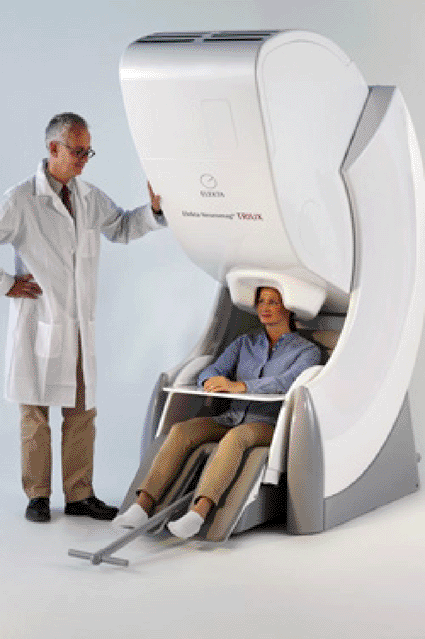Magnetic Platform Investigates Human Brain Activity
By MedImaging International staff writers
Posted on 21 Dec 2010
An updated magnetoencephalography (MEG) system addresses requirements that are critical for robust functional mapping studies, particularly in patients with epilepsy. Posted on 21 Dec 2010
The Elekta Neuromag TRIUX system is designed to operate in virtually any clinical environment due to a dynamic range that has been increased three-fold, in addition to built-in active shielding, which protects the ultrasensitive sensor array. These improvements make the system suitable for placement in busy hospitals and research centers. The system also provides several features designed to simplify day-to-day use, such as a new easy access connector panel and a gantry that allows clinicians and researchers to conduct MEG measurements with the patient in a more comfortable upright position.

Image: The Elekta Neuromag TRIUX system (photo courtest Elekta).
Further benefits of the Elekta Neuromag TRIUX system include higher tolerance for magnetic interference, internal active shielding that neutralizes magnetic interference without additional weight or size, new user interface features, and patient comfort enhancements. The Elekta Neuromag TRIUX system is a product of Elekta (Stockholm, Sweden).
"In many clinical research studies, MEG has shown value in the detection of epileptic activity for presurgical evaluation,” said Stephen Otto, chairman of Neuromag Business at Elekta. "MEG provides a noninvasive method to accurately pinpoint the origin of seizure activity by measuring spikes between seizures. It is well tolerated by patients and has been shown to be more sensitive than the functional imaging modalities of PET and SPECT.”
MEG was initially used for fundamental brain research, but an increasing number of hospitals are using the technology for variety of applications, including epilepsy studies. Current studies indicate that up to 25% or more of patients with epilepsy are refractory to all forms of medical therapy; these patients are candidates for surgical treatment in an attempt to achieve better seizure control, while minimizing functional impairment caused by the operation. MEG is used to locate the exact regions of the brain responsible for various functions, and to determine the best surgical route to keep these functions intact.
Related Links:
Elekta














